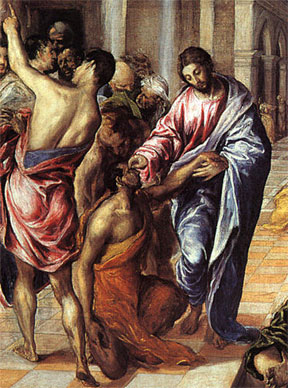Part 3 of series: The Mission of God and the Missional Church
Permalink for this post / Permalink for this series
If you were to ask the average Christian, “What was the mission of Jesus?” you’d no doubt hear that Jesus came to die on the cross for our sins, so that we might have eternal life. I believe this is true, profoundly and wonderfully. But I also believe it’s not the full story. The mission of Jesus, though ultimately centered in the cross and though leading to life after death, was far more inclusive than many of us have been led to believe. In this post and the next I’ll give a quick overview of the mission of Jesus as seen from the perspective of the Old Testament mission of God.
Hundreds of years after the Hebrew prophet Isaiah delivered the message of the coming kingdom of God, another man recognized as a Jewish prophet emerged on the scene, bringing a message reminiscent of Isaiah’s. In a nutshell, he proclaimed: “At last the time has come! The Kingdom of God is near! Turn from your sins and believe this Good News!” (Mark 1:15). Could this man, Jesus son of Joseph from Nazareth, be the one whom God sent to “bring good news of peace and salvation, the news that the God of Israel reigns” (Isa 52:7)?
One sabbath day Jesus went to the religious gathering place in his hometown. He was given the scroll containing the prophecies of Isaiah. Turning to the 61st chapter, He read:
The Spirit of the Lord is upon me, for he has appointed me to preach Good News to the poor. He has sent me to proclaim that captives will be released, that the blind will see, that the downtrodden will be freed from their oppressors, and that the time of the Lord’s favor has come (Luke 4:18-19).
 There was nothing particularly unusual about the fact that Jesus read this text. It was well-known and beloved among the Jews of Jesus’s day, who hoped for God’s kingdom. But then Jesus did a most exceptional thing. As those who had gathered stared at Him, he said: “This Scripture has come true today before your very eyes!” (Luke 4:21). With this simple sentence Jesus made an audacious claim. In effect, He said, “I am the one appointed by the Holy Spirit to fulfill this prophecy of Isaiah. I am the long-expected Redeemer of Israel, the Servant of God who will bear the sin of humanity. I have come to complete God’s mission of reconciliation.” (Picture above: The great Isaiah Scroll from Qumran, one of the first Dead Sea Scrolls to be discovered in 1947. It is an almost complete copy of Isaiah, and dates to the second-century BC.)
There was nothing particularly unusual about the fact that Jesus read this text. It was well-known and beloved among the Jews of Jesus’s day, who hoped for God’s kingdom. But then Jesus did a most exceptional thing. As those who had gathered stared at Him, he said: “This Scripture has come true today before your very eyes!” (Luke 4:21). With this simple sentence Jesus made an audacious claim. In effect, He said, “I am the one appointed by the Holy Spirit to fulfill this prophecy of Isaiah. I am the long-expected Redeemer of Israel, the Servant of God who will bear the sin of humanity. I have come to complete God’s mission of reconciliation.” (Picture above: The great Isaiah Scroll from Qumran, one of the first Dead Sea Scrolls to be discovered in 1947. It is an almost complete copy of Isaiah, and dates to the second-century BC.)
The passage from Isaiah 61 which Jesus applied to Himself highlights several essential features of his mission. First of all, He was sent by God in the power of the Holy Spirit (Luke 4:18). Even though Jesus was the divine Son of God, He was empowered by the Holy Spirit for His ministry. Even though His birth was a miracle of the Spirit, at His baptism by John in the Jordan River, Jesus received the Spirit in a dramatic way (Luke 3:21-22). From that time onward He was guided by the Spirit (Luke 4:1).
Second, Jesus was sent to proclaim the good news (Luke 4:18). At the core of His earthly ministry was the proclamation of God’s reign. The Gospel of Mark provides a concise summary of Jesus’s message: “At last the time has come! The Kingdom of God is near! Turn from your sins and believe this Good News!” (Mark 1:15). Notice that Jesus’s own preaching was not primarily about Himself, but about the coming of the long-awaited kingdom of God, that which the prophets had promised and for which the Jewish people prayed every day.
What is this kingdom of God? In the Old Testament, the kingdom of God was not somewhere up in the sky, or something we experience only after death. Rather, it was God’s reign or rule on earth, a reign that would continue into eternity. The establishment of God’s kingdom on earth brings reconciliation between people and God, and extends that reconciliation throughout the world. Hatred and injustice are replaced by the love and justice of God. Sickness and death are consumed by God’s wholeness and eternal life. Human rebellion against God’s reign is replaced by loving obedience. (For much more on Jesus’s preaching of the kingdom of God, see my series: What Was the Message of Jesus?)
Part 4 of series: The Mission of God and the Missional Church
Permalink for this post / Permalink for this series
Yesterday I began to summarize the mission of Jesus in light of the mission of God in the Old Testament. I based my discussion on a passage from chapter 4 of Luke’s gospel. Here’s that passage, once again:
The Spirit of the Lord is upon me, for he has appointed me to preach Good News to the poor. He has sent me to proclaim that captives will be released, that the blind will see, that the downtrodden will be freed from their oppressors, and that the time of the Lord’s favor has come (Luke 4:18-19).
On the basis of this text, which is a citation from Isaiah 61, I explained that:
1. Jesus was sent by God in the power of the Holy Spirit.
2. Jesus was sent to proclaim the good news.
Today I’ll continue where I left off yesterday.
 Third, Jesus was sent to enact the good news. Jesus practiced what He preached. As a part of His announcement of God’s coming kingdom, Jesus proclaimed release for the captives, seeing for the blind, and freedom for the oppressed. He backed up His audacious proclamations with compelling demonstrations. Those in bondage to demonic powers were set free (Luke 4:33-35). The sick were made well and the blind given sight (Luke 7:21-22). Jesus liberated those who were bound by social injustice and prejudice (Mark 7:24-30; Luke 5:12-15; 7:36-50; 8:43-48; 10:38-42; 19:1-10). Even as he called his followers to love their neighbors and their enemies (Luke 6:35; 10:27), Jesus also loved with exemplary compassion (Matt 9:36; Mark 10:21; Luke 7:13). He not only spoke of God’s reign, but also embodied that reign in His own person and ministry. Where Jesus was, there was the kingdom of God (Luke 17:21). His enactment of the kingdom demonstrated the validity of His preaching, and drew thousands to hear His good news. It showed that the coming of the kingdom was focused in Him, His proclamation, His ministry, and His person. (Picture: El Greco, “Christ Healing the Blind,” c. 1567)
Third, Jesus was sent to enact the good news. Jesus practiced what He preached. As a part of His announcement of God’s coming kingdom, Jesus proclaimed release for the captives, seeing for the blind, and freedom for the oppressed. He backed up His audacious proclamations with compelling demonstrations. Those in bondage to demonic powers were set free (Luke 4:33-35). The sick were made well and the blind given sight (Luke 7:21-22). Jesus liberated those who were bound by social injustice and prejudice (Mark 7:24-30; Luke 5:12-15; 7:36-50; 8:43-48; 10:38-42; 19:1-10). Even as he called his followers to love their neighbors and their enemies (Luke 6:35; 10:27), Jesus also loved with exemplary compassion (Matt 9:36; Mark 10:21; Luke 7:13). He not only spoke of God’s reign, but also embodied that reign in His own person and ministry. Where Jesus was, there was the kingdom of God (Luke 17:21). His enactment of the kingdom demonstrated the validity of His preaching, and drew thousands to hear His good news. It showed that the coming of the kingdom was focused in Him, His proclamation, His ministry, and His person. (Picture: El Greco, “Christ Healing the Blind,” c. 1567)
Fourth, Jesus was sent to form a community of the good news. Although not explicitly stated in Luke 4:18-19, when the poor, the blind, and the captives received the good news of God’s kingdom, they also had the opportunity to join the community of kingdom people, who, once reconciled to God, experienced reconciliation with each other as well. In Luke 5 Jesus called a few fishermen to form the core of His disciples, promising that they would now fish for people (Luke 5:1-11; 6:12-16). The community of Jesus’s followers live under God’s reign, demonstrating love and justice as servants of God and of each other (Mark 10:43-44; Luke 11:42; John 13:34-35). Even during the earthly life of Jesus, His followers were empowered to join in His ministry, proclaiming the good news of God’s reign and demonstrating that good news through works of healing and liberation (Luke 9:1-2; 10:1-17). Their sharing in the ministry of Jesus foreshadowed an even greater work to come.
So, even as in the Old Testament God’s mission involved forming a people through whom to restore His kingdom on earth, Jesus’s mission was not simply about getting individuals right with God. He was also in the business of forming a people to proclaim and live out the reality of God’s kingdom. This is perhaps one of the major oversights in much of American Christianity, which has allowed the individualism of American culture to obscure the essentially communal nature of Jesus’s mission. Yes, He came to secure individual salvation and to call individuals as His disciples. But full salvation includes restoration as God’s people. True discipleship is always a shared endeavor. There are no “lone ranger” disciples in the kingdom of God (or at least there shouldn’t be).
Fifth, Jesus was sent to consummate the good news through His death and resurrection. Though He embodied and inaugurated God’s reign on earth, human response to Jesus was still limited by sin. Without experiencing the most profound kind of liberation – from sin, our rebellion against God – we cannot be reconciled to God. Until we are cleansed from our sin, we can long for God’s kingdom, but we cannot fully enter it. Jesus was sent not only to proclaim and to demonstrate the good news of God’s reign, but also to consummate that good news by overcoming the barrier of sin. He came, “not to be served but to serve others, and to give [His] life as a ransom for many” (Mark 10:45). He was sent to fulfill the mission of Isaiah’s suffering Servant of God, the one who would be “wounded and crushed for our sins,” upon whom “the Lord laid . . . the guilt and sins of us all” (Isa 53:5-6). Because God’s rightful reign over us was shattered by sin, the shattering of sin by the death and resurrection of Jesus enables us to be reconciled to God. Once reconciled, then we can live in full fellowship with him as citizens of His kingdom. The cross of Christ invites us into the kingdom of God and restores us into intimate fellowship with Him as God’s subjects, servants, and beloved children.
In my next post I’ll show how this kingdom-centered mission of Jesus has been passed on to us.

